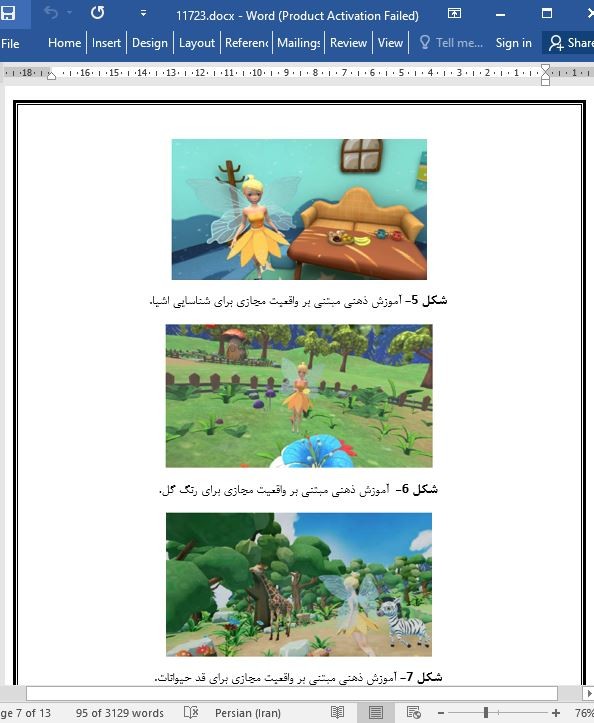
تاثیر آموزش شناختی مبتنی بر واقعیت مجازی بر کودکان مبتلا به اختلال طیف اوتیسم
چکیده
واقعیت مجازی (VR) یک محیط مصنوعی است که از طریق محرک های حسی که یک رایانه ایجاد میکند، تجربه می شود. قابلیت VR برای شبیه سازی واقعیت دسترسی به درمان های روانی را تا حد زیادی افزایش میدهد. برای تحلیل تأثیر آموزش ذهنی مبتنی بر VA روی کودکان مبتلا به اختلال طیف اوتیسم (ASD) مدل آموزش مداخله زود هنگام و بازخورد هوشمند جزئی ایجاد شد. برای کمک به شدت علائم و اثربخشی درمان آموزش ذهنی مبتنی بر VA در کودکان مبتلا به ASD ، از لیست بررسی رفتار اوتیسم (ABC) ، مقیاس درجهبندی اوتیسم دوران کودکی (CARS) و مقیاس رفتار اوتیسم Clancy (کابین) استفاده شد. نتایج نشان داد که آموزش ذهنی مبتنی بر VA برای کودکان مبتلا به ASD بسیار جذاب بود؛ آموزش ذهنی مبتنی بر VA علائم معمول (اختلال ارتباط اجتماعی ، تاخیر گفتاری، کم توجهی و رفتار جدی) کودکان مبتلا به ASD را به طور چشمگیری بهبود بخشید و طی 4 هفته پس از درمان لیست بررسی رفتار اوتیسم (ABC)، مقیاس درجهبندی اوتیسم دوران کودکی (CARS) و مقیاس رفتار اوتیسم را بهبود بخشید (کابین ها). داده ها حاکی از آن است که آموزش ذهنی مبتنی بر VA ممکن است روش خوبی برای درمان کودکان مبتلا به ASD باشد.
1- مقدمه
اختلال طیف اوتیسم (ASD) اصطلاحی است که برای توصیف مجموعهای از نواقص ارتباط اجتماعی زودهنگام و رفتارهای تکراری حسی - حرکتی مرتبط با یک مولفه ژنتیکی قوی و همچنین دلایل دیگر استفاده می شود (لرد و همکاران ، 2018). ASD با مشکل در ارتباط اجتماعی و الگوهای رفتاری، علاقهای یا فعالیتهای محدود و تکراری مشخص می شود (سانچاک و توماس ، 2016).
5- نتیجه گیری
آموزش ذهنی مبتنی بر VA کودکان مبتلا به ASD بسیار جذاب بود. آموزش شناختی مبتنی بر VA به طور قابل توجهی علائم معمول (اختلال ارتباط اجتماعی ، تاخیر گفتاری، کم توجهی و رفتار جدی کودکان مبتلا به ASD) را بهبود بخشید و لیست بررسی رفتار اوتیسم (ABC) ، مقیاس درجهبندی اوتیسم در کودکان (CARS) . مقیاس رفتاری اوتیسم را (کابین ها) طی 4 هفته پس از درمان کامل کرد. داده ها حاکی از آن است که آموزش ذهنی مبتنی بر VA ممکن است روش خوبی برای درمان کودکان مبتلا به ASD باشد.
Abstract
Virtual reality (VR) is an artificial environment which is experienced through sensory stimuli provided by a computer. The capability of VR to simulate reality could greatly increase access to psychological therapies. The model of early intervention training and partial intelligent feedback was established to analyze the effect of cognitive training based on VA on children with autism spectrum disorder (ASD). The Autism Behavior Checklist (ABC), Childhood Autism Rating Scale (CARS) and Clancy Autism Behavior Scale (CABS) were used to assist the severity of symptoms and treatment effectiveness of cognitive training based on VA on children with ASD. The results showed that the cognitive training based on VA was very attractive to children with ASD; cognitive training based on VA significantly improved the typical symptoms (the social communication disorder, speech retardation, narrow interest and rigid behavior) of children with ASD and perfected the Autism Behavior Checklist (ABC), Childhood Autism Rating Scale (CARS) and Autism Behavior Scale (CABS) during 4 weeks after treatment. The data suggested that cognitive training based on VA might be a good method to treat children with ASD.
1. Introduction
Autism spectrum disorder (ASD) is a term used to describe a constellation of early-appearing social communication deficits and repetitive sensory-motor behaviors associated with a strong genetic component as well as other causes (Lord et al., 2018). ASD is characterized by difficulty with social communication and restricted, repetitive patterns of behavior, interest, or activities (Sanchack and Thomas, 2016).
5. Conclusion
The cognitive training based on VA was very attractive to children with ASD; cognitive training based on VA significantly improved the typical symptoms (the social communication disorder, speech retardation, narrow interest and rigid behavior of children with ASD) and perfected the Autism Behavior Checklist (ABC), Childhood Autism Rating Scale (CARS) and Autism Behavior Scale (CABS) during 4 weeks after treatment. The data suggested that cognitive training based on VA might be a good method to treat children with ASD.
چکیده
1- مقدمه
2- مواد و روشها
2-1- تشخیص ASD در کودکان
2-2- شركت كنندگان
2-3- روش های کاربردی VA
2-4- آموزش ذهنی مبتنی بر VA
2-5- ارزیابی معالجه کودکان مبتلا به ASD
2-6- تحلیل آماری
3- نتایج
3-1- جذابیت آموزش ذهنی مبتنی بر VA برای کودکان مبتلا به ASD
3-2- بهبود علائم معمول پس از آموزش ذهنی مبتنی بر VA کودکان مبتلا به ASD
3-3- تغییر مقیاسهای درجهبندی بالینی پس از آموزش ذهنی مبتنی بر VA کودکان مبتلا به ASD
4- بحث و گفتگو
5- نتیجه گیری
رفرنس
Abstract
1. Introduction
2. Materials and methods
2.1. Diagnosis of child ASD
2.2. Participants
2.3. Application methods of VA
2.4. Cognitive training based on VA
2.5. Treating assessment for the children with ASD
2.6. Statistical analysis
3. Results
3.1. Attraction of cognitive training based on VA for children with ASD
3.2. Improve typical symptoms after cognitive training based on VA in children with ASD
3.3. Changes of the clinical rating scales after cognitive training based on VA in children with ASD
4. Discussion
5. Conclusion
References
- اصل مقاله انگلیسی با فرمت ورد (word) با قابلیت ویرایش
- ترجمه فارسی مقاله با فرمت ورد (word) با قابلیت ویرایش، بدون آرم سایت ای ترجمه
- ترجمه فارسی مقاله با فرمت pdf، بدون آرم سایت ای ترجمه



